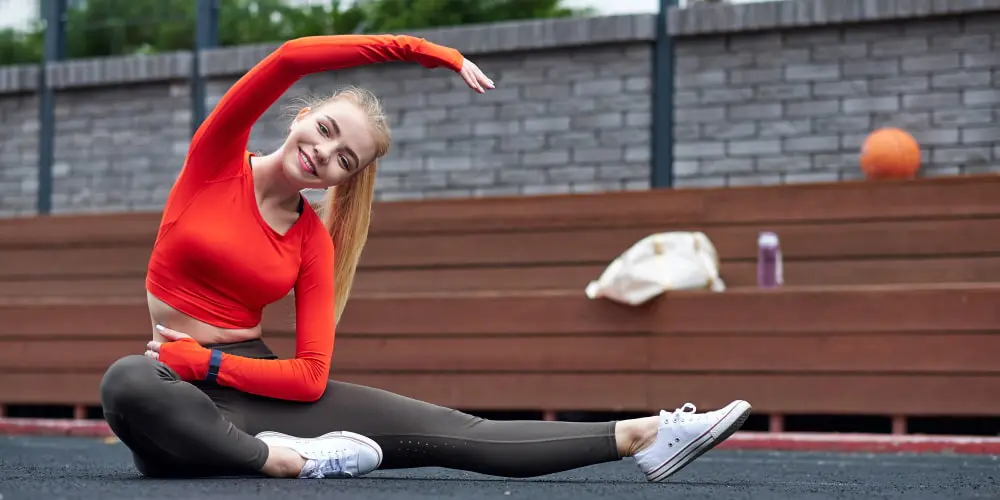A passive lifestyle negatively affects the condition of all organs and systems. It is essential to devote time to sports every day. We prepare special exercises for you to improve blood circulation. They do not require intense physical activity. Static exercises are enough to improve blood circulation. It is essential to perform them daily to achieve results. Choose the options that you like to make them easier to implement. People with sedentary work need to exercise blood circulation. Then, you will always be full of energy.
These exercises are specifically designed to stimulate blood flow and improve vascular health. Also, they aim to enhance overall circulation efficiency. They are from simple movements to more intense workouts.
A wide range of exercise options suit individuals of all fitness levels. It doesn’t matter whether you’re looking to alleviate symptoms of poor circulation. Let’s delve into the top ones to help you achieve better blood circulation and overall well-being.
The Importance of Exercise for Blood Circulation
Exercise is pivotal in maintaining optimal blood circulation throughout the body. They promote cardiovascular health and support overall well-being. Here’s why blood flow exercise is crucial:
- Enhanced Heart Function: Regular physical activity strengthens the heart muscle. It enables it to pump blood more efficiently. This improved heart function ensures oxygen-rich blood reaches the various tissues and organs. It promotes smooth functioning.
- Improved Blood Vessel Health: Exercise helps to keep blood vessels flexible and clear of obstructions. It reduces plaque build-up in the arteries and thus prevents diseases such as atherosclerosis. These can impede blood flow and lead to cardiovascular diseases such as heart attacks and strokes.
- Lower Blood Pressure: Regular circulation exercise can help regulate blood pressure levels. It promotes better dilation of vessels. Also, it reduces resistance to blood flow and consequently lowers pressure. This helps to protect against hypertension, a significant risk factor for heart disease.
- Enhanced Circulation to Extremities: Adequate blood circulation delivers nutrients and oxygen to them. Among such exercises are the arms and legs, which remove waste products. Regular exercise promotes the development of collateral circulation. It ensures that blood flow remains sufficient even in the smallest blood vessels.
- Prevention of Blood Clots: Physical activity reduces the risk of blood clots. It happens by improving blood flow and preventing stagnation. This lowers the likelihood of conditions like deep vein thrombosis (DVT) and pulmonary embolism. They can have serious health consequences if left untreated.
- Improved Endothelial Function: Exercise influences endothelial function and the lining of blood vessels. It enhances the production of nitric oxide. This molecule helps blood vessels relax and dilate. It improves blood flow and reduces the risk of vascular dysfunction.
- Management of Chronic Conditions: Regular exercise for blood circulation benefits such individuals. Among them are diabetes and obesity. They help to regulate blood sugar levels, manage weight, and improve insulin sensitivity. By addressing these underlying factors, exercise can indirectly support better blood circulation.
- Mental Health Benefits: Physical activity not only benefits the body but also the mind. It reduces stress, anxiety, and depression, which can contribute to improved cardiovascular health. Mental well-being is closely linked to physical health. It creates a positive feedback loop that supports overall vitality.
Incorporating various aerobic, strength training, and flexibility exercises into one’s routine is vital. It can maximize blood circulation and overall health benefits. It’s essential to consult with a healthcare professional before starting any new exercise regimen. This is especially crucial for individuals with pre-existing medical conditions.
Top 3 Exercises to Improve Circulation
Improving circulation is crucial for maintaining overall health and vitality. Regular physical activity is key in enhancing blood flow throughout the body. It supports cardiovascular function and reduces the risk of various health conditions. Exercises to improve circulation are efficient at boosting circulation by increasing heart rate. They promote blood vessel dilation and strengthen the cardiovascular system. Here are the top 3 exercises tailored to enhance circulation and optimize well-being.
Brisk Walking
This is a simple yet effective cardiovascular exercise that improves circulation. Maintaining a brisk pace elevates your heart rate and increases blood flow. This activity engages the calf muscles. It facilitates venous return from the legs and promotes circulation to the extremities. Brisk walking is accessible to people of all fitness levels. It can be easily incorporated into daily routines, such as walking to work or taking a brisk stroll during lunchtime. Regular brisk walking sessions, ideally totaling at least 30 minutes most days of the week. It can help lower blood pressure, reduce the risk of cardiovascular diseases, and enhance overall well-being.
Cycling
Cycling is widely regarded as one of the best exercises for promoting blood flow throughout the body. Whether pedaling outdoors or on a stationary bike, cycling engages large muscle groups in the legs. It supports efficient circulation. The rhythmic cycling motion encourages blood to flow more freely through arteries and veins. It delivers oxygen and nutrients to tissues while removing waste products. Cycling is a low-impact activity, making it accessible to people of all ages and fitness levels. Regular cycling improves cardiovascular health and strengthens the heart. Also, it lowers the risk of conditions like heart disease and stroke.
Swimming
It is one of the essential exercises to improve circulation. This is due to its holistic benefits for cardiovascular health. Its low-impact nature makes it accessible to people with joint issues or mobility limitations. Swimming engages both upper and lower body muscles. It promotes efficient blood flow throughout the body. The resistance is generally provided by water. It enhances muscle strength and endurance while encouraging rhythmic breathing. The buoyancy of water reduces stress on joints, making it an ideal exercise for rehabilitation and injury prevention. It doesn’t matter whether you are performing laps in a pool or enjoy open water swimming. Incorporate swimming into your fitness routine. It will improve circulation, cardiovascular fitness, and overall well-being.
Blood Flow Exercises: Tips for Beginners
Blood flow exercises are crucial for maintaining optimal circulation and overall health. For beginners, starting a new exercise regimen can be intimidating. With the right approach, it can be both manageable and rewarding. You can improve circulation by incorporating simple yet effective techniques into your routine. Also, you may enhance your well-being. Let’s explore some of the best exercises and offer tips for beginners to get started on their journey to better circulation.
Squats
Squats are widely regarded as one of the best exercises for blood flow. This is due to their ability to engage multiple muscle groups simultaneously. When performed correctly, squats target the quadriceps, hamstrings, glutes, and lower back muscles. It is promoting increased blood circulation throughout the lower body. The dynamic movement in squats encourages the heart to pump blood more efficiently. It delivers oxygen and nutrients to working muscles while flushing out metabolic waste products. Squats can help improve flexibility, joint mobility, and balance, enhancing cardiovascular health. It doesn’t matter whether using bodyweight squats or incorporating resistance. It may be dumbbells or a barbell; adding squats to your workout routine can improve blood flow, muscular strength, and overall fitness.
Foam Roller Stretch
Using a foam roller for stretching is a fantastic blood flow exercise with many benefits. It releases muscle tension and tightness, promoting better circulation and flexibility. Target specific muscle groups by rolling the foam roller beneath your body. This is while applying gentle pressure to perform a foam roller stretch. Focus on areas prone to tightness, such as the calves, hamstrings, quadriceps, and back. Hold positions where you feel tension for 30 seconds to a minute, allowing the muscles to relax and lengthen. Incorporating foam roller stretches into your routine can alleviate muscle soreness. Also, it improves the range of motion and enhances overall physical well-being. Ensure proper form and avoid rolling directly over joints or areas of acute pain.
Heel Lifts
Heel lifts are among the best exercises for blood flow, particularly in the lower extremities. This simple exercise involves standing with feet hip-width apart and slowly lifting your heels. Then, lowering them back down. Repeat this motion several times, aiming for 10-15 repetitions. Heel lifts engage the calf muscles, promoting venous return and leg circulation. They can be virtually done anywhere, making them convenient for daily routines. Heel lifts can help prevent deep vein thrombosis (DVT) and improve calf muscle strength and endurance. As with any exercise, it’s essential to perform heel lifts with proper form and gradually increase intensity as tolerated.
Walking
Walking is a simple yet effective blood flow exercise that can be easily incorporated into daily life. It requires no special equipment. You can do this exercise almost anywhere, making it accessible to people of all ages and fitness levels. Aim for brisk walking to elevate your heart rate and promote circulation. The rhythmic movement of walking engages the calf muscles. It helps facilitate venous return from the legs and encourages blood flow throughout the body. Regular walking improves cardiovascular health and boosts overall well-being.
Conclusion
It is essential to exercise regularly for blood circulation. Incorporating them can promote the improvement of general well-being. It is pivotal to stay active and maintain a consistent exercise routine. Then, you can get rid of chronic fatigue and prevent the development of serious diseases. For personalized guidance, consult Lone Star Neurology, the trusted Neurological Center. We have only highly qualified healthcare professionals.
FAQ
How long should I exercise for optimal blood circulation?
Aim for at least 30 minutes of moderate-intensity exercise most days of the week for optimal blood circulation. Health guidelines recommend so.
How does exercise affect blood flow?
Exercise promotes vasodilation, enhances endothelial function, and increases heart rate. All of these contribute to improved blood flow.
Can exercise for blood circulation reduce health risks?
Yes, regular blood circulation exercise can reduce cardiovascular disease risk. Also, it decreases hypertension and other health conditions associated with poor circulation.
Are there exercises I should avoid for blood circulation issues?
People with circulatory problems should avoid strenuous exercise. High exertion can make symptoms worse.
Can poor circulation be reversed with exercise?
Yes, regular exercise can help improve circulation. It strengthens the heart and dilates blood vessels. Also, regular exercises promote efficient blood flow.





 (1 votes, average: 4.00 out of 5)
(1 votes, average: 4.00 out of 5)







Please, leave your review
Write a comment: